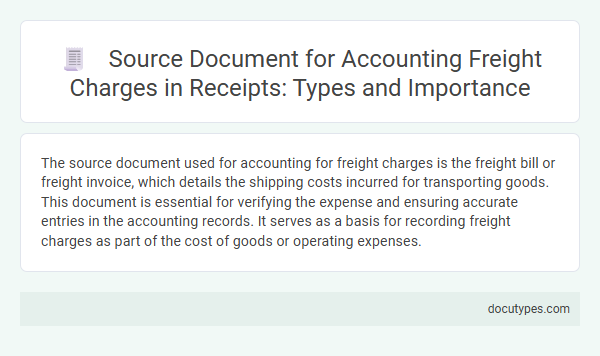The source document used for accounting for freight charges is the freight bill or freight invoice, which details the shipping costs incurred for transporting goods. This document is essential for verifying the expense and ensuring accurate entries in the accounting records. It serves as a basis for recording freight charges as part of the cost of goods or operating expenses.
Introduction to Source Documents in Accounting
Source documents serve as the original records for accounting transactions, providing essential evidence of business activities. For freight charges, the bill of lading or freight invoice is the key source document used to record these costs accurately in accounting systems. Your accurate freight documentation ensures proper expense tracking and financial reporting in your accounting process.
Understanding Freight Charges in Receipts
What source document is used for accounting for freight charges? The bill of lading serves as the primary source document for recording freight charges in accounting. It details shipping terms and costs, ensuring accurate entry in your financial records.
Types of Source Documents for Freight Charges
Source documents used for accounting freight charges include freight bills, invoices from carriers, and delivery receipts. These documents provide detailed information on shipping costs, item descriptions, and delivery terms essential for accurate financial records. You must ensure proper verification of these source documents to maintain accurate accounting for freight expenses.
Importance of Accurate Source Documents
Source documents such as freight bills play a crucial role in accounting for freight charges. Accurate source documents ensure that all shipping costs are properly recorded and managed in your financial statements.
- Freight Bill - The primary source document detailing the cost and terms of freight services.
- Importance of Accuracy - Precise information on the freight bill prevents errors in expense reporting and financial analysis.
- Audit Trail - These documents provide verifiable evidence for shipment costs during audits and financial reviews.
Common Receipt Formats for Freight Charges
Source documents used for accounting freight charges are essential for accurate financial records. Common receipt formats capture detailed information necessary for expense tracking and auditing.
- Bill of Lading - This document serves as proof of shipment and includes freight costs associated with transporting goods.
- Freight Invoice - Issued by carriers, it specifies charges for shipping services, serving as a primary source for accounting entries.
- Shipping Receipt - Provided upon delivery, this receipt confirms freight charges and serves as evidence for payment validation.
Your accounting system should incorporate these source documents to ensure precise recording of freight expenses.
Key Information Required in Freight Receipts
| Source Document for Accounting Freight Charges | Freight receipt or freight bill |
|---|---|
| Purpose | Serves as an official proof of shipment and charges incurred for transporting goods |
| Key Information Required in Freight Receipts |
|
| Accounting Use | The document verifies transportation costs for accurate ledger entries and expense tracking |
| Recommendation | You should ensure that freight receipts contain complete details to maintain clear audit trails and proper accounting controls. |
Role of Source Documents in Financial Auditing
The source document used for accounting freight charges is typically the freight bill or freight invoice provided by the carrier. These documents serve as crucial evidence of the transportation costs incurred by a business.
- Verification Tool - Freight bills act as primary evidence for auditors to verify the accuracy of recorded freight expenses.
- Cost Allocation - Source documents ensure proper allocation of freight charges to relevant accounts or inventory costs.
- Compliance Proof - These documents demonstrate compliance with contractual and regulatory requirements during financial audits.
Maintaining accurate freight source documents strengthens internal controls and supports transparent financial reporting.
Best Practices for Managing Freight Source Documents
Freight source documents, such as bills of lading and freight bills, serve as primary evidence for accounting freight charges. These documents provide detailed information on shipment costs, carrier details, and delivery terms, crucial for accurate financial records.
Best practices for managing freight source documents include maintaining organized digital and physical records to ensure easy retrieval during audits. Consistent verification of freight charges against source documents helps prevent billing errors and strengthens internal controls.
Challenges in Tracking Freight Charges in Receipts
The source document used for accounting for freight charges is the freight bill or delivery receipt. This document details the shipping costs and serves as proof of delivery for the goods received.
Tracking freight charges in receipts poses several challenges. Inconsistent documentation formats can lead to errors in data entry and reconciliation. Discrepancies between the freight bill and actual charges complicate accurate accounting. You must ensure all freight-related expenses are correctly matched to corresponding purchase orders to maintain accurate financial records.
What Source Document Is Used for Accounting for Freight Charges? Infographic

